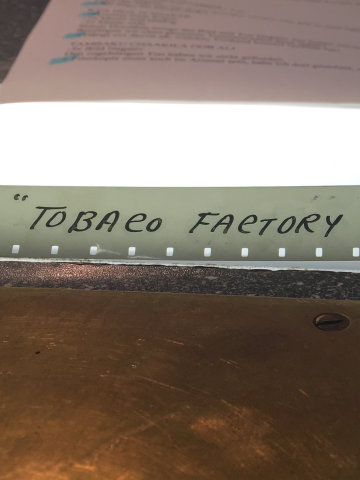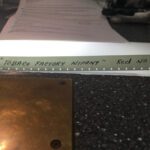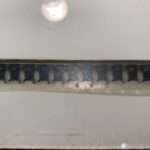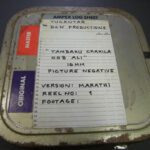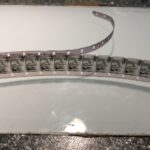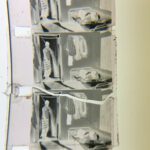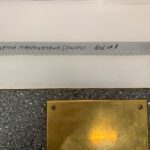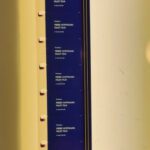To restore, retouch, revive –
a material journey
THIS SITE IS A PART OF FILM restoration and research process, designed to acknowledge Yugantar’s rich histories by giving access to their films, keeping them in circulation for multiple audiences, to be seen, thought with and extended into present and future struggles.
The films themselves have changed their materiality and passed through many different locations, labs, hands and desktops—scratched 16mm film prints that travelled throughout India as objects are now circulating as digital files.
Timeline
2011: In November 2011 Deepa Dhanraj travelled to London, her hand luggage full with whatever Yugantar film material she had found still available in her cellar—roughly 22kg of 16mm film prints, some picture and sound negatives and magnetic soundtracks. What seemed like the only surviving material was then carefully carried from London to Berlin where the Yugantar films joined 1000s of film copies in the Arsenal film archive. The worn out film prints—partly also affected by the vinegar syndrome, the chemical deterioration of the acetate film base—were inspected and prepared for a screening on the Steenbeck table (an editing table that is also used for watching film prints) and filmed off the small screen to attain a digital copy as working and research material.
The film materials started another journey. From travelling across India on top of busses, moving through numerous different 16mm projectors, rewound many times for indoor and outdoor screenings, in cinema halls, meeting rooms, outside spaces of political groups, closed off highways; exposed to heat and humidity when stored, the weathered prints now traversed different film labs and postproduction houses in Germany.
The film elements were inspected, damages were repaired, and the material was cleaned. The following digital process included technical, conceptual and ethical questions: What does digitally restoring such materials of a specific time and place mean: To capture the production history of a film that also reflects in analog “imperfections” and limitations as well as traces that were added throughout time? Or to aim for a digital intervention that pleases the spectators eyes and ears in its result by accommodating the way we are trained to perceive film nowadays? How does one negotiate between a “theoretical” restoration ethic, the interests of the filmmaker, the practice of a film archive (and cinema), and an audience? How does a collaboration across distance, between a German institution and a former feminist collective in India unfold through the personal connections that develop through these very material processes?
2011-2013: “Living Archive—Archive Work as a Curatorial and Artistic Practice”, a project by Arsenal – Institute for Film and Video Art, offers a framework to digitally restore the film Kya Hua is Shaher Ko (D: Deepa Dhanraj) and to publish it on a DVD with booklet subsequent to its re-screening within the Berlinale Forum 2013. (The film was presented in the same section of the Berlin International Film Festival in 1988, following which the Arsenal holds a 16mm film print with German subtitles in its archive.)
2013-2017: Due to missing funds the restoration of the Yugantar films is being postponed.
2017-2021: The Arsenal project “Archive ausser sich” offers the opportunity to continue the work on the Yugantar films. Deepa Dhanraj accompanies the color grading and restoration of Tambaku Chaakila Oob Ali, Idi Katha Maatramena, and Molkarin in Berlin in 2018.
2019: The digital restorations of Tambaku Chaakila Oob Ali and Idi Katha Maatramena premiere within the Berlinale Forum program in attendance of Deepa Dhanraj and Abha Bhaiya
2020/21: A (second) print of SUDESHA is located in Germany, the digital restoration is carried out and presented at the festival Archival Assembly #1 at Arsenal cinema.
Technical aspects of the digital restoration process
Molkarin (Maid Servant)
Existing analogue elements—
(1) 16mm positive print, b&w, optical soundtrack, 25 min; language version: Hindi. This print shouldn’t be projected anymore.
(2) 16mm picture positive, b&w, mute, fragments: censors certificate board and titles
Origin of elements: Deepa Dhanraj
MOLKARIN was digitized in 2018 based on the 16mm positive print which remains the only traceable element of the film to this point. The print shows a considerable degree of various kinds of physical damage due to abrasion from projection.
The digitization (2K) was carried out at Kornmanufaktur, Concept AV and Poleposition d.c. (Berlin) as well as ARRI Media (Munich).
Tambaku Chaakila Oob Aali
Existing analogue elements—
(1) 16mm positive print, b&w, optical soundtrack, 26 min; language version: Marathi
Origin: Navina Sundaram. Some frames are missing in the print. This print is still suitable for projection.
(2) 16mm positive print, b&w, optical soundtrack, 19 min (incomplete print); language version: Marathi. This print is not suitable for projection anymore.
(3) 16mm original camera negative, b&w, mute, 3 cans, complete
Origin of elements (2—3): Deepa Dhanraj
Tambaku Chaakila Oob Aali was digitally restored in 2018 based on the 16mm original camera negative. The 16mm positive print has been used as a source element for the opening credits and the soundtrack. All elements show a considerable degree of various kinds of physical damage.
The digital restoration (2K) was carried out at ARRI Media in Berlin and Munich, Omnimago (Wiesbaden) and Poleposition d.c. (Berlin).
Idi Katha Maatramena (Is this just a story?)
Existing analogue elements—
(1) 16mm positive print, b&w, optical soundtrack, 26 min; language version: Telugu. This print shouldn’t be projected anymore.
(2) 16mm original camera negative, b&w, mute, 3 cans, complete
Origin of elements: Deepa Dhanraj
Idi Katha Maatramena was digitally restored in 2018 based on the 16mm original camera negative. The complete 16mm positive print has been used as a source element for the opening credits and the soundtrack. All elements show a considerable degree of various kinds of physical damage.
Specific challenges in the processing occurred in a sequence of three meters in the original camera negative in which the original perforation was replaced in the past. Due to the different extend of horizontal shrinkage of the picture negative and the added perforation, both materials separated over time. In addition, the extend of vertical shrinkage was different on both sides which led to a warp defect in the image.
The digital restoration (2K) was carried out at ARRI Media in Berlin and Munich, Omnimago (Wiesbaden) and Poleposition d.c. (Berlin).
Two video clips exemplify the relation between before and after the digital restoration:
// Idhi Katha hand scan—The beginning of the clip shows the scanning result of one specific sequence of the negative. Here the perforation was missing on one side for which reason the negative has to be put in the scanner by hand frame by frame. The second part of the clip shows the restored and stabilised result of this sequence. Still noticeable is a slight warping effect on the left side which occurred through the shrinkage of the negative.
// Comparison Idi Katha—The left side of the clip shows the positive print which was used as the source for the soundtrack (which is also hearable before its restoration). The right side shows the restored picture based on the camera negative which contains frames that are missing in the positive print at the beginning. It was decided to keep the full length of the negative which implies that the soundtrack starts later.
Sudesha
// 16mm positive print, color (faded), optical soundtrack.
Existing elements—
(1) 16mm positive print, color, optical soundtrack, 33 min; language version: Hindi. This print is color faded, is noticeably shrunken and shows a high level of acetic acid (vinegar syndrome). The print is not suitable for projection anymore.
Origin of element: Deepa Dhanraj
(2) 16mm positive print, color, optical soundtrack, 33 min; language version: German voice over.
Origin of element: EZEF (Evangelisches Zentrum für entwicklungsbezogene Zusammenarbeit), Berlin
Sudesha was digitally restored in 2020 and 2021 and is based on the 16mm archive print from EZEF. The soundtrack of the original language version was digitised from the 16mm print that was preserved by Deepa Dhanraj.
The original camera negative was preserved in Germany. Since the production company couldn’t afford the storage fee anymore, the negative was destroyed. This happened in 2014, only three years before the restoration of the Yugantar films started.
The digital restoration (2K) was carried out at Kornmanufaktur, CBBB Postproduction and Poleposition d.c. in Berlin as well as Worozbytmedia in Munich)
The digital restorations of all four Yugantar films were undertaken in close collaboration with Deepa Dhanraj, partly also participating at the color grading and the sound restoration. The work took place within the framework of “Archive ausser sich”, a project by Arsenal – Institute for Film and Video Art in cooperation with Haus der Kulturen der Welt as part of “The New Alphabet”, a HKW project supported by the Federal Government Commissioner for Culture and the Media due to a ruling of the German Bundestag.
All analogue elements, except for the 16mm print of SUDESHA from EZEF’s archive, are stored at the archive of Arsenal – Institute for Film and Video Art, Berlin upon agreement with the Yugantar collective.
Restoration as collaboration
A conversation between Deepa Dhanraj and Markus Ruff, with Nicole Wolf
Nicole: The Yugantar films arrived in the Arsenal archive through my prior connection with the Arsenal. I was invited to be a participant of the Arsenal’s “Living Archive” project and through that a possibility arose to finally see and maybe make available again those films that I had wanted to see for many years. I already experienced Deepa bringing all available film material to London and allowing me to take it to Berlin as a huge gesture of trust. I think the weight of the film copies made itself felt as absolute excitement and immense responsibility. I had the knowledge of the political history of the Arsenal and its archive filled with markers of radical film history and trusted that the films would be acknowledged for what they were and that future relations with filmmakers would be on respectful terms. At the same time, I was aware of the politics of activist films from India entering a German institution which would provide the financial base and the technical Know-How to restore and digitize them, with me being a white European facilitator of this process as well as a researcher on the project, and a possibility of the films ultimately becoming part of the archive. I knew absolutely nothing about digital restoration before this project and while I was not involved in many aspects of the process, I learned a lot and I realized the significance that small decisions within e.g. the color grading process can have in the context of broader conceptual questions. I did feel I saw the films anew once they were digitized, with significant details becoming more visible and audible.
How would you both describe your approach for entering this specific project? What for you were significant moments or experiences for this process to work well, mostly across distance, during the course of ten years, with Deepa only present in Berlin for two weeks during one summer? What was important in terms of how communication took place between different sides? When did this process feel like a collaboration and when possibly not and why? Can you articulate what your understanding of trust in this process was?
Markus: First, I'd like to briefly address two points you made: the financial aspect and the expertise. The latter absolutely exists in India—or especially in India— in the field of digital restoration. For example, for the restoration of GHASHIRAM KOTWAL (Yukt Film Cooperative, Mani Kaul) we worked together with one facility in India. The question remains who can—or cannot—afford it. The financing of a digitization or digital restoration (incidentally also the storage of film material) is of course also a big challenge in Germany, independent of the country the films are produced in. Yet, it becomes even more tricky once you deal with a so called foreign production. – The logic of German cultural funding along the lines of heritage, i.e. national heritage, would take the conversation in a different direction.— The fact here is that the films found their way into Arsenal’s archive (until the Yugantar collective decides otherwise) and that we were able to undertake the digital restoration. And in such constellation the aspect of power relations that you mentioned before is crucial and must be constantly reflected on, on institutional as well as on a personal level.
I have been working at the Arsenal archive since 2011, thus "Living Archive" was more or less the project through which I was getting involved with digitization projects. It was in this context, so at the very beginning of me entering this particular field, that we met and we have worked together ever since, always focusing on the restoration of all five films [the first title was KYA HUA IS SHAHAR KO? directed by Deepa]. Such a long collaboration connects, and for me I can say that personal relationships are an essential aspect in my work. Today I can't remember our first meeting at the Arsenal and the suitcase full of film reels—not to speak of what went through my mind. However, in connection with other projects where filmmakers entrust the Arsenal with their films and the digitization, this situation repeats in a way, and I am aware that it goes hand in hand with a great deal of trust. Sometimes they don't know the institution beforehand, or not very well, and we meet for the first time, or the films are handed over to us by a third person, as in this case by Nicole. At this point I wonder what creates the trust, especially since there is no physical proximity, and in this sense no immediate access to the material for the filmmakers.
Deepa: It is very hard for a filmmaker to have your films disappear. Films go missing not because they are misplaced or stolen but because they simply wear themselves out. Film prints disintegrate after multiple screenings and cannot be projected any more. They begin to exist as images in memory and can only be brought to life by “talking” the film, describing sequence by sequence so that the listener can “see” the film. When Nicole asked me about the missing films both Kya Hua Is Shahar Ko? and the Yugantar films this is how I described them, like a script narration. Then it didn’t seem likely that they could be seen again as a film ought to be. So when the news came that Arsenal could take on the restoration, initially of Kya Hua is Shahar Ko?, for me it was an incredibly exciting moment.
I had no idea what was involved in a restoration process, especially when we had to work with a damaged negative and reconstruct the soundtrack from a mix of an optical track and magnetic tapes. Markus was working with the Arri lab and had to explain why certain sections looked the way they did because of the vinegar syndrome. Discussions as to whether something should be retouched in the digital restoration process or just left as it was bearing the marks of time brought into focus questions of authenticity, historical fidelity and archival process. These had to be negotiated.
It was a steep learning curve and I think even though it was a long distance process we managed to communicate across countries and time zones. Building trust for me was achieved in the process of working together, on every aspect, the image quality, construction of the sound track, the new subtitles and I have to thank you Markus for your meticulousness and attention to detail and patience in answering all my questions! I suppose for you too it was about understanding what my expectations were, thank you for reminding me of what was realistically possible!
Markus: When the filmmaker is involved in the restoration process, there is the need to clearly communicate the approach. This may contradict with the director’s intention in the first place, and somehow it’s in the nature of things. However, the discussion about the details—even if it may get nerdy sometimes—is usually productive. It’s a dialogue of sharing perspectives from different backgrounds, all in favor of the film and how we preserve the film best in a truthful way for current and future generations. I like this process very much, and nothing is more satisfying for me than a satisfied filmmaker. I think that we have achieved that together.
Deepa: Watching the final version on a big screen for the first time after so many years was a very emotional moment that I will never forget. After the Kya Hua is Shahar ko? restoration I think we had established a very easy and comfortable working relationship, so the Yugantar films were very easy to do.
Markus: Yes, with this first project we established a comfortable way of working together, and you already had a clearer idea of our approach—not only in technical terms regarding the restoration, but also the curatorial practice. However, the Yugantar films had their own challenges, different ones from Kya Hua is Shahar ko, so we kept on “negotiating” details. Each film is different in a way and poses new questions and challenges in the process.
Nicole: Reading your reflections I am reminded on the one hand that this collaboration started with locating Kya Hua is Shahar ko? in the Arsenal archive. When I searched earlier for a copy of Kya Hua is Shahar ko? it never occurred to me that the film print would be here in Berlin, but while researching for a film series curated on the basis of the Arsenal’s collection of Indian films Kya Hua I Shahar ko? showed up. You both stress that working on this film together first was crucial to create a certain basis of trust and I wonder if maybe also just the fact that the Arsenal had once screened a film that the Indian Embassy would rather not have shown internationally and preserved it mattered, and that everyone recognized that this was an important political film to make available again.
The other aspect is maybe also your understanding and experience Markus of working on other films from the Indian context and with Indian film labs.
And it strikes me that you both accentuate the personal and working out an appropriate decision making process for each individual film together, rather than coming with a preset idea of what digital restoration must do and what the end results should be. This impression I get from your description which lets the institution and what is structurally determined fade a bit in the background, though it never vanishes.
And as you say Markus, the collective could decide any day to take the prints out of the archive and there was a common agreement that the online versions of the films should be available for free online for audiences in India and on request from other regions outside Europe and North America.
Markus: Making films accessible online is complex. On which platform and in which territory a film can be made accessible remains a case-by-case decision dependent on legal issues. In the case of the Yugantar films, we discussed and weight up together what is possible and how. The starting point for the digitization of these films was always in the foreground: making them accessible to workers and unions in India, and that they can be shown without restriction in different contexts. That was the intention with which the films were produced, and nowadays that can be achieved in the digital in a different way. Making the films freely accessible online in India was the expressed wish of the collective, and it would be absurd for an institution to oppose the original intention—at least once you engage in such a project. I think that in this specific case we have found fitting solutions for different contexts.
Regarding the approach to digitization I must add: when we speak of a (digital) restoration, there are definitely interventions that are not possible. Otherwise, the final product would "simply" have to be called something else but not a restoration. As a film institution with a film educational mission (Filmvermittlungsauftrag), however, we do not intent to falsify films in the digital processing, i.e. producing a digital copy in which the production history of a film is no longer recognizable. Especially in the case of the Yugantar films, this is exemplary: TAMBAKU, for example, shows that strikes took place in the 1980s and that the women workers were able to obtain better conditions back then, something that is unknown to the workers today. If the film now pretended to have been shot yesterday, I think it would lose its authenticity and power for audiences today. Nevertheless, I recognize that the film is the work of a person or persons with an aesthetic aspiration, and this I do not leave out of view where possible and justifiable.
Deepa: The restoration process continued over a ten-year period, it is remarkable that we were able to give the same level of attention and care to each film. I felt we all had the same sense of investment in this project. Finally, I want to say that at the end of this journey the friendship is special and will endure.

